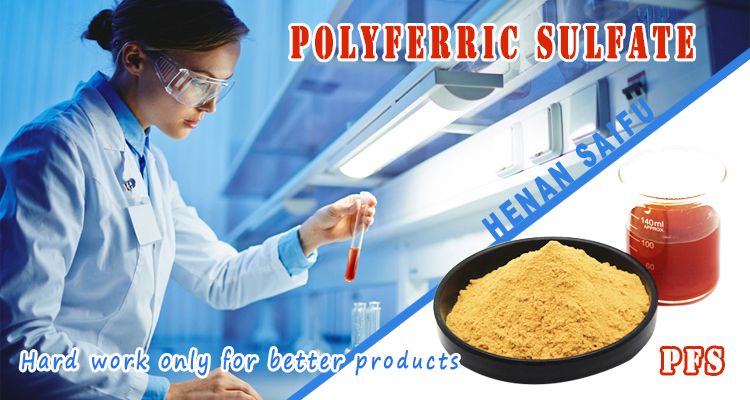E-mail: admin@saifutd.com Tel: 86-13598853789
E-mail: admin@saifutd.com Tel: 86-13598853789
news
1. Characteristics
Polymeric ferric sulfate (PFS) is a high molecular polymer. Its morphology is a light yellow amorphous powdery solid, which is easily soluble in water. An aqueous solution with a mass fraction of 10% is a reddish brown transparent solution and is highly hygroscopic.

2. Mechanism of action
Polyferric sulfate is a cationic coagulant of polyhydroxy and multinuclear complex. Its aqueous solution contains a large amount of polymerized iron complex ions, which can electrically neutralize the colloidal particles suspended in the water, reduce the potential, and quickly condense the colloidal particles in the water into large particles. It also has adsorption and bridging agglomeration effects, making the particles Flocculate into large particles, accelerate particle settlement, and achieve the purpose of water purification.
3.Use
Polyferric sulfate is a new, high-quality, high-efficiency iron salt inorganic polymer coagulant with excellent water purification effect and good water quality after purification. Polyferric sulfate does not contain harmful substances such as Al, Cl2 and heavy metal ions, and there is no water transfer of Fe3+. It is non-toxic, harmless, safe and reliable, and can remove turbidity, decolorization, deoiling, dehydration, sterilization, deodorization, algae removal and It has remarkable effects in removing chemical oxygen demand (COD), biochemical oxygen demand (BOD) and heavy metal ions in water. Polyferric sulfate can be used to treat industrial wastewater (such as printing and dyeing wastewater), and is also widely used in foundry, papermaking, medicine, tanning, etc. It has excellent coagulation performance, dense alum flowers, and fast sedimentation speed; it is suitable for water pH values ranging from 4.0 to 11.0, and the optimal pH value range is 6.0 to 9.0. The pH and total alkalinity of the purified raw water change slightly, which is very harmful to the treatment equipment. It is less corrosive; it has a significant effect on purifying micro-pollution, algae-containing, low-temperature and low-turbidity raw water, and is especially effective on high-turbidity raw water; it has low dosage and low cost.

4. How to use
When used, the liquid polymerized ferric sulfate is generally formulated into a 10% to 50% aqueous solution (it can be added directly when the raw water turbidity is high), and the solid polymerized ferric sulfate is formulated into a 10% to 30% aqueous solution, and then added according to the specific situation. The prepared solution is added according to the optimal conditions and dosage, and the best coagulation effect can be obtained after sufficient stirring. The dosage of polyferric sulfate can be determined according to the different turbidity of the raw water. For general turbid water (turbidity between 100-500 mg/L), use 30-50 kg/1000 t of this product; for non-drinking water with high turbidity Industrial sewage can be added appropriately. When the main purpose is to remove phosphorus, the total phosphorus in the effluent is different, and the position of the polymerized ferric sulfate that can be added is different. The phosphorus content is relatively small and can be added to the primary sedimentation tank; when the phosphorus content is relatively high, coagulant can be added to the effluent of the secondary sedimentation tank and filtered; when there is no biochemical tank, polymerization can be added directly Ferric sulfate, plus flocculant.

Our company successfully completed the shipment of an urgent order for polyacrylamide.Shipping Date: August 25, 2025Recently, a batch of polyacrylamide (PAM) products of a specified model completed final inspection at our finished goods warehouse and was loaded onto a truck for shipment to a well-kn

Recently, our company reached a long-term cooperation agreement with an Indonesian environmental protection company, exporting a full container of polyaluminum chloride and polyacrylamide to them.Photo of the cargo being loaded at the port.After several rounds of discussions with the customer, we re